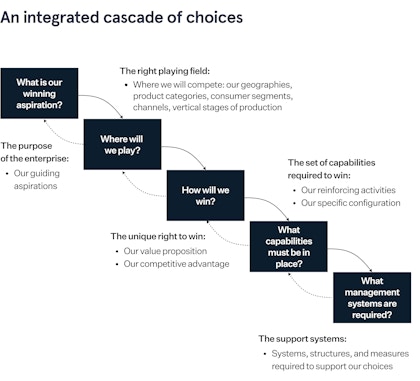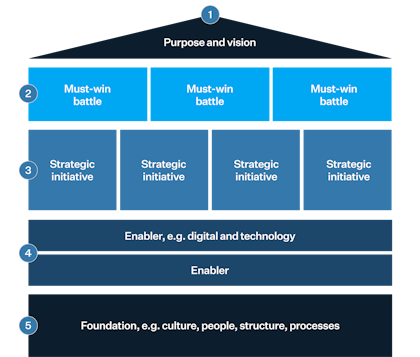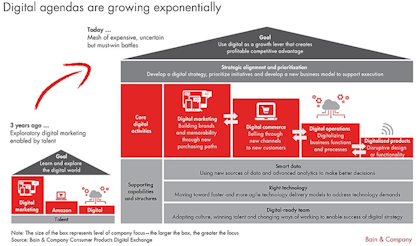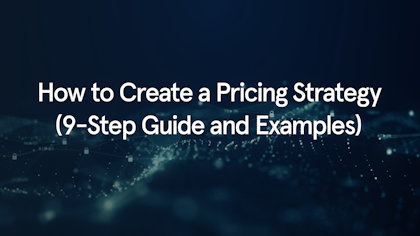Creating a strategy document is a critical step for any business looking to achieve its goals. However, the process can be daunting, especially if you're not sure where to start. Fortunately, big management consulting houses like McKinsey, Bain, and The Boston Consulting Group (BCG) are experts at this exact topic and have put out thousands of articles, frameworks, and presentations with advice on how to do this.
Here, we have outlined the five essential elements of a successful strategy document. We have also developed a ready-to-use template based on the McKinsey and BCG approach so you can easily create a comprehensive and effective strategy that will help your business thrive.
The five essential elements are:
- Define your goal (and not just your vision and mission)
- Make sure you make tough choices
- Have a clear and compelling structure
- Don’t fall into the tactics trap
- Remember to be actionable
Let’s dive into each element.
1. Define your goals (and not just your vision and mission)
This may seem like a trivial or obvious step but surprisingly many strategy documents fail to outline a goal and ambition level. Instead, many simply assume the goal is inherent like “make as much money as possible” or “keep growing”.
However, without a concrete goal, it’s difficult to craft effective strategic tactics and initiatives and more importantly decide between initiatives and how to allocate resources.
Strategy is at its heart the art and science of choosing where to spend limited resources (both time and money), and this is nearly impossible without clearly knowing what you are trying to achieve.
Best practice is to set a SMART goal. A SMART goal is a specific, measurable, achievable, relevant, and time-bound goal. Align your goals with your company strategy:
- Make your goals specific: Clearly define what you aim to achieve with your goals. This helps ensure that everyone understands the objective.
- Ensure your goals are measurable: Establish metrics that will be used to track progress and success. This helps your company and stakeholders monitor whether you are achieving the desired results.
- Make your goals achievable: Avoid setting overly ambitious goals that may be demotivating and unattainable. Instead, ensure that your goals are realistic and achievable.
- Ensure your goals are relevant: Make sure that your goals are directly connected to (or at least not conflicting with) your company's overall vision and mission.
- Set a deadline: Add a month and year that these goals should be attained (typically at least by the next strategy cycle). This creates a sense of urgency and accountability.
Examples of SMART goals in the context of business strategy could be e.g.:
By the end of the fiscal year 2027, achieve 60% recyclable packaging for all products, while reducing carbon emissions by 50% and increasing revenue from sustainable products by 20%, through targeted sustainability initiatives and innovation efforts.
By the end of the fiscal year 2023, increase annual revenue by 25%, through a combination of expanding our product line, entering two new markets, and improving our customer acquisition and retention strategies
Note, before you set your goal(s) you should make sure your company’s vision and mission are clear. These will most often not change significantly between strategy cycles.
It’s also important to understand that vision/mission are not the same as your goal and ambition level, despite what Google and ChatGPT might make you think.
The vision and mission statements in your strategy document serve as the guiding principles, providing direction and purpose to your organization. Your goals are the tangible outcomes that you are striving to achieve within that framework. They define the specific objectives that your organization needs to accomplish to realize your vision and mission, and serve as a measurable benchmark of success.
By following these steps, you can set objectives that are well-defined, attainable, and in line with your strategic vision, ultimately driving success and progress towards your larger strategic aims.
2. Make sure you make tough choices
A good strategy document answers the fundamental questions of ‘where to play’ and ‘how to win’. In other words, you need to define your playing field (which industries, geographies, customer segments, product categories etc. you want to operate within) and what your unique competitive advantage will be (e.g. price, value proposition, supply chain setup, distribution etc.).
What is equally important is to define what you will not do. Although this is often not an explicit part of the final strategy document it is a crucial part of the overall process.
Making (hard) choices is the essence of creating a strategy but it is also one of the most difficult disciplines and often it’s easier to focus on the urgent and short-term actionable things.
According to renowned strategic thinkers Roger Martin and A.G. Lafley, many organizations fail to make these hard choices and instead define their strategy in one of the following ineffective ways:
- they define strategy as a vision;
- they define strategy as a plan;
- they deny that long-term strategy is possible;
- they define strategy as the optimization of the status quo; and
- they define strategy as following best practices.
“These ineffective approaches,” Martin and Lafley write in their seminal 2013 book Playing to Win: How Strategy Really Works, “are driven by a misconception of what strategy really is and a reluctance to make truly hard choices.”
Although it might seem tempting to create as broad and open a strategy as possible to allow for unforeseen opportunities or avoid closing down projects or firing team members, this is the strategic equivalent of peeing your pants to stay warm. Only by making hard choices can you achieve real focus and truly set your organization up to ‘win’.
In the end, your scope and competitive advantage should be clear and succinct. If you cannot articulate on a single page your high-level ‘where to play’ and ‘how to win’ (and what you at the same time will not do) then you need to go back and redo the exercise.
3. Have a clear and compelling structure
When we use the words clear and compelling it’s not just consulting lingo. Clear means your document structure must be logical, easily understandable, and set up in a visually appealing way. Compelling means your document structure must read like a story that keeps the audience engaged and is both straightforward to follow and easy to explain to others.
Although this seems simple, the structure and storyline are in fact what often makes McKinsey and BCG strategy slides feel different and somehow more authoritative than most other strategy presentations.
So how to do this in practice? There are many different ways but in general it’s a good idea to follow a structure that logically goes from ‘where do we want to go’ (goal, vision, mission) to ‘what are the big things we need to focus on to get there’ (initiatives, focus areas) to ‘what are the things we need to be able to do to execute on those big things’ (sub-initiatives, concrete tasks) to ‘how does that plan look in practice’ (timeline, roadmap, resource allocation).
One way of translating this into actual slides is to use the infamous ‘strategy house’, which both McKinsey, Bain, and BCG use in their strategy presentations.
You can see more tips on constructing consulting-like presentations in our blog post 'How McKinsey Consultants Make PowerPoint Presentations'.
4. Don’t fall into the tactics trap
Strategy and tactics are two terms that are often used interchangeably, but they have distinct meanings in the context of business. Understanding the difference is paramount to creating an effective strategy document.
Strategy is a long-term plan of action that outlines how an organization will achieve its goals and objectives. It involves making decisions about where to focus resources, which markets to enter or exit, how to differentiate from competitors, and how to allocate resources. In short, it's the big-picture plan that guides an organization towards its vision and mission.
On the other hand, tactics refer to the short-term actions taken to achieve specific objectives within the broader framework of a strategy. Tactics are specific and concrete actions that are implemented to achieve a particular goal. They are often described as the means of executing a strategy.
This long-term-first thinking seems easy enough to understand on paper, but is surprisingly hard to do in practice. Since most days are spent on the nitty-gritty, day-to-day execution, these ideas have a tendency to sift into the strategy document and become their own priorities or focus areas. Too often we have seen strategy documents that are essentially a series of tactics or a list of well-meaning initiatives. Sometimes teams try to backengineer a goal and strategic ambition from the list of tactics, which is never a good idea.
Put bluntly, if an initiative or idea in the strategy document cannot be linked directly back to the main objectives and overarching goals, then it shouldn’t be included in the strategy and have resources allocated towards it.
But what if it’s a great idea, you say? Cutting costs or squeezing an extra 5% of sales out of existing channels seem like no-brainers, but remember prioritizing one thing always means de-prioritizing something else. Without an overall cohesive strategy you risk missing out on the actions that truly move the needle.
So to summarize, strategy is the overall plan that guides an organization towards its goals, while tactics are the specific actions taken to achieve these goals in the short term. Don’t fall into the trap of stringing together a series of good tactics and hoping it becomes a cohesive strategy.
5. Remember to be actionable
Once you have identified your strategic goals, scope and priorities/initiatives, it's important to develop an action plan or roadmap that outlines the specific initiatives and timelines needed to achieve them. This involves breaking down your initiatives into smaller, actionable steps and assigning responsibilities and deadlines to each one. Your roadmap should ideally also include a budget and resource allocation plan to ensure you have the necessary resources to execute your initiatives.
Regularly review and update your roadmap to ensure you are on track to achieving your goals and adjust as needed based on changes in the market or business environment.
Together, these five essential elements will help lift your strategy document from good to great, and hopefully make your overall strategy process a lot easier.
Dive into our other blog posts to learn more about creating high-impact presentations
See our blog post on Getting to the So What to learn how to turn observations into insights.
Read about how you create and use Action Titles for effective and compelling presentations.
Explore the mutually-exclusive-collectively-exhaustive (MECE) framework to help you structure your arguments.
...or take a look at the full list of posts on our blog site.
















